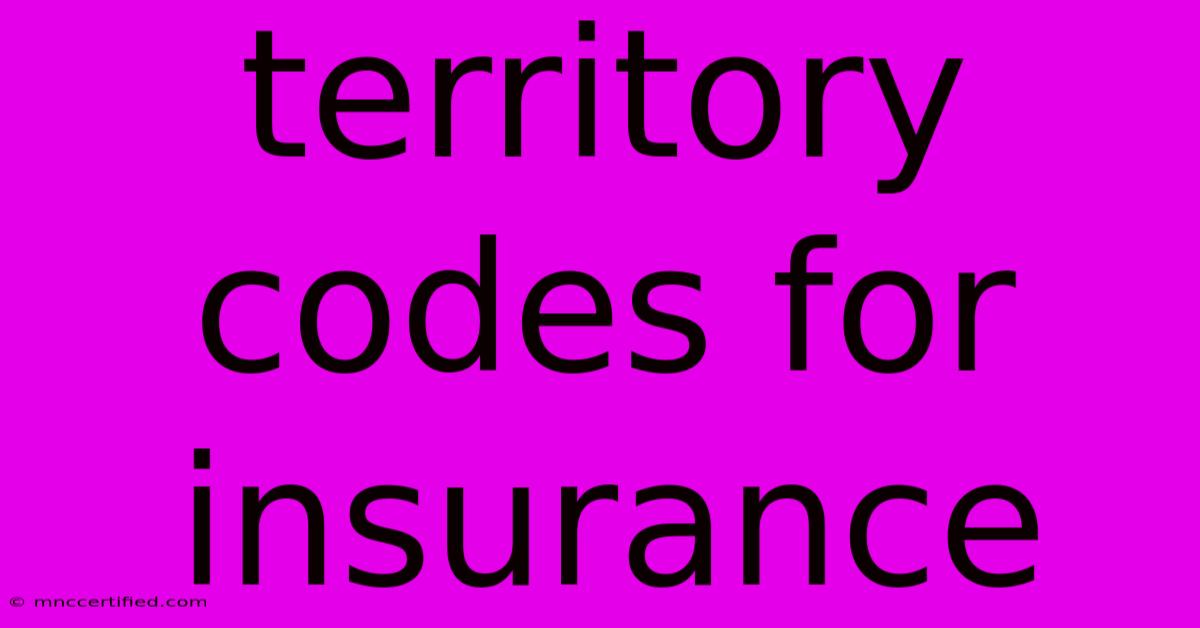Territory Codes For Insurance

Table of Contents
Understanding Territory Codes in Insurance: A Comprehensive Guide
Territory codes in insurance are crucial for determining premiums and coverage. They're often overlooked, but understanding how they work can significantly impact your insurance costs and the level of protection you receive. This comprehensive guide will break down everything you need to know about territory codes, from their purpose to how they affect your policy.
What are Territory Codes?
Insurance companies divide their service areas into territories based on various factors influencing risk. These factors include:
- Geographic Location: This is the primary factor. Areas with higher crime rates, more frequent natural disasters (like hurricanes, earthquakes, or wildfires), or higher rates of vehicle accidents will generally fall into higher-risk territories.
- Demographics: Population density, age demographics, and income levels can all influence risk assessment.
- Claims History: Areas with a history of higher insurance claims (e.g., more frequent car accidents or home burglaries) will likely have higher territory codes.
These territories are assigned numerical or alphanumeric codes. The higher the code number, the higher the risk associated with that area, and consequently, the higher your insurance premiums may be. It's important to note that these codes are not standardized across all insurance companies. Each insurer uses its own proprietary system.
How Territory Codes Affect Your Insurance Premiums
Your assigned territory code directly influences your insurance premium. A higher-risk territory with a higher territory code will result in a higher premium. This is because the insurance company anticipates a greater likelihood of claims in these areas.
For example, a home located in a territory with a high frequency of burglaries might have a higher territory code, leading to a more expensive homeowner's insurance policy compared to a similar home in a lower-risk area. Similarly, a car insurance policy in an area with a high number of accidents might have a higher premium due to the higher territory code.
Finding Your Territory Code
Unfortunately, your territory code isn't always readily available to you. It's often an internal identifier used by the insurance company. You might be able to find it on your insurance policy documents, or by contacting your insurer directly and asking about your assigned territory.
Are Territory Codes Fair?
The fairness of territory codes is a topic of debate. While they are based on statistical risk assessment, critics argue that they can lead to disparities in insurance costs, particularly affecting individuals in lower-income neighborhoods or areas historically marginalized. These areas may have higher crime rates due to socioeconomic factors rather than inherent risk.
Insurance companies argue that territory codes are necessary to accurately reflect risk and maintain financial stability. Without them, premiums would need to be uniformly higher, potentially making insurance unaffordable for many.
How to Potentially Lower Your Insurance Costs Related to Territory Codes
While you can't change your geographic location, you can still take steps to lower your overall insurance costs:
- Improve your credit score: Credit history often plays a role in insurance premiums.
- Maintain a clean driving record: For car insurance, this is critical in reducing costs.
- Install security systems: Home security systems can lower your homeowner's insurance premium.
- Bundle your policies: Bundling car and home insurance with the same company can lead to discounts.
- Shop around: Compare quotes from multiple insurance providers, as territory codes vary between companies.
Conclusion: Understanding is Key
Understanding territory codes is crucial for informed decision-making about your insurance coverage. While you can't control the code assigned to your location, knowing how it affects your premiums can help you make better choices about your insurance policy and potentially reduce your overall costs. By actively engaging with your insurer and taking steps to mitigate risk, you can work towards a more affordable and comprehensive insurance plan. Remember to always compare quotes from different insurance providers to find the best coverage at the most competitive price.

Thank you for visiting our website wich cover about Territory Codes For Insurance. We hope the information provided has been useful to you. Feel free to contact us if you have any questions or need further assistance. See you next time and dont miss to bookmark.
Featured Posts
-
Shelter Insurance Hastings Ne
Nov 29, 2024
-
Inbox Pulling For Him Is Easy
Nov 29, 2024
-
Title Insurance Jobs New York
Nov 29, 2024
-
Reviews Lions Bears Special Event
Nov 29, 2024
-
Europa League Man Utd Lineup Prediction
Nov 29, 2024